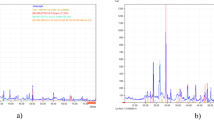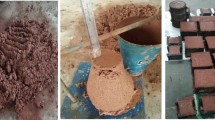Abstract
Multi-technique characterisation of sodium carbonate-activated blast furnace slag binders was conducted in order to determine the influence of the carbonate groups on the structural and chemical evolution of these materials. At early age (<4 days) there is a preferential reaction of Ca2+ with the CO3 2− from the activator, forming calcium carbonates and gaylussite, while the aluminosilicate component of the slag reacts separately with the sodium from the activator to form zeolite NaA. These phases do not give the high degree of cohesion necessary for development of high early mechanical strength, and the reaction is relatively gradual due to the slow dissolution of the slag under the moderate pH conditions introduced by the Na2CO3 as activator. Once the CO3 2− is exhausted, the activation reaction proceeds in similar way to an NaOH-activated slag binder, forming the typical binder phases calcium aluminium silicate hydrate and hydrotalcite, along with Ca-heulandite as a further (Ca,Al)-rich product. This is consistent with the significant gain in compressive strength and reduced porosity observed after 3 days of curing. The high mechanical strength and reduced permeability developed in these materials beyond 4 days of curing elucidate that Na2CO3-activated slag can develop desirable properties for use as a building material, although the slow early strength development is likely to be an issue in some applications. These results suggest that the inclusion of additions which could control the preferential consumption of Ca2+ by the CO3 2− might accelerate the reaction kinetics of Na2CO3-activated slag at early times of curing, enhancing the use of these materials in engineering applications.








Similar content being viewed by others
References
van Deventer JSJ, Provis JL, Duxson P (2012) Technical and commercial progress in the adoption of geopolymer cement. Miner Eng 29:89–104
Provis JL, van Deventer JSJ (2014) Alkali-activated materials: state-of-the-art report RILEM TC 224-AAM. Springer, Dordrecht
Provis JL (2014) Green concrete or red herring? – the future of alkali-activated materials. Adv Appl Ceram. doi:10.1179/1743676114Y.0000000177
Provis JL (2014) Geopolymers and other alkali activated materials - Why, how, and what? Mater Struct 47(1):11–25
Wang S-D, Pu X-C, Scrivener KL, Pratt PL (1995) Alkali-activated slag cement and concrete: a review of properties and problems. Adv Cem Res 7(27):93–102
Puertas F (1995) Cementos de escoria activados alcalinamente: situación actual y perspectivas de futuro. Mater Constr 45(239):53–64
Juenger MCG, Winnefeld F, Provis JL, Ideker J (2011) Advances in alternative cementitious binders. Cem Concr Res 41(12):1232–1243
Duxson P, Provis JL (2008) Designing precursors for geopolymer cements. J Am Ceram Soc 91(12):3864–3869
Shi C, Krivenko PV, Roy DM (2006) Alkali-Activated Cements and Concretes. Taylor & Francis, Abingdon
Provis JL, Bernal SA (2014) Geopolymers and related alkali-activated materials. Annu Rev Mater Res 44(1):299–327
Wang SD, Scrivener KL, Pratt PL (1994) Factors affecting the strength of alkali-activated slag. Cem Concr Res 24(6):1033–1043
Živica V (2007) Effects of type and dosage of alkaline activator and temperature on the properties of alkali-activated slag mixtures. Constr Build Mater 21(7):1463–1469
Fernández-Jiménez A, Puertas F (2003) Effect of activator mix on the hydration and strength behaviour of alkali-activated slag cements. Adv Cem Res 15(3):129–136
Shi C, On the state and role of alkalis during the activation of alkali-activated slag cement. In: Proceedings of the 11th International Congress on the Chemistry of Cement, Durban, South Africa, 2003
Song S, Sohn D, Jennings HM, Mason TO (2000) Hydration of alkali-activated ground granulated blast furnace slag. J Mater Sci 35:249–257
Zhou H, Wu X, Xu Z, Tang M (1993) Kinetic study on hydration of alkali-activated slag. Cem Concr Res 23(6):1253–1258
Puertas F, Martínez-Ramírez S, Alonso S, Vázquez E (2000) Alkali-activated fly ash/slag cement. Strength behaviour and hydration products. Cem Concr Res 30:1625–1632
Ben Haha M, Le Saout G, Winnefeld F, Lothenbach B (2011) Influence of activator type on hydration kinetics, hydrate assemblage and microstructural development of alkali activated blast-furnace slags. Cem Concr Res 41(3):301–310
Kashani A, Provis JL, Qiao GG, van Deventer JSJ (2014) The interrelationship between surface chemistry and rheology in alkali activated slag paste. Constr Build Mater 65:583–591
Krivenko PV (1994) Alkaline cements. In: Krivenko PV (ed) Proceedings of the first international conference on alkaline cements and concretes. VIPOL Stock Company, Kiev, pp 11–129
Xu H, Provis JL, van Deventer JSJ, Krivenko PV (2008) Characterization of aged slag concretes. ACI Mater J 105(2):131–139
Provis JL, Duxson P, Kavalerova E, Krivenko PV, Pan Z, Puertas F, van Deventer JSJ (2014) Historical aspects and overview. In: Provis JL, van Deventer JSJ (eds) Alkali-activated materials: state-of-the-art report, RILEM TC 224-AAM. Dordrecht, Springer, pp 11–57
Provis JL, Brice DG, Buchwald A, Duxson P, Kavalerova E, Krivenko PV, Shi C, van Deventer JSJ, Wiercx JALM (2014) Demonstration projects and applications in building and civil infrastructure. In: Provis JL, van Deventer JSJ (eds) Alkali-activated materials: state-of-the-art report, RILEM TC 224-AAM. Dordrecht, Springer, pp 309–338
Moseson AJ, Moseson DE, Barsoum MW (2012) High volume limestone alkali-activated cement developed by design of experiment. Cem Concr Compos 34(3):328–336
Sakulich AR, Miller S, Barsoum MW (2010) Chemical and microstructural characterization of 20-month-old alkali-activated slag cements. J Am Ceram Soc 93(6):1741–1748
Moseson AJ. (2011) Design and implementation of alkali activated cement for sustainable development. Ph.D. Thesis, Drexel University
Bai Y, Collier N, Milestone N, Yang C (2011) The potential for using slags activated with near neutral salts as immobilisation matrices for nuclear wastes containing reactive metals. J Nucl Mater 413(3):183–192
Bakharev T, Sanjayan JG, Cheng Y-B (1999) Alkali activation of Australian slag cements. Cem Concr Res 29(1):113–120
Fernández-Jiménez A, Puertas F (2001) Setting of alkali-activated slag cement. Influence of activator nature. Adv Cem Res 13(3):115–121
Duran Atiş C, Bilim C, Çelik Ö, Karahan O (2009) Influence of activator on the strength and drying shrinkage of alkali-activated slag mortar. Constr Build Mater 23(1):548–555
Fernández-Jiménez A, Puertas F, Sobrados I, Sanz J (2003) Structure of calcium silicate hydrates formed in alkaline-activated slag: influence of the type of alkaline activator. J Am Ceram Soc 86(8):1389–1394
Wang YX, De Carlo F, Mancini DC, McNulty I, Tieman B, Bresnahan J, Foster I, Insley J, Lane P, von Laszewski G, Kesselman C, Su MH, Thiebaux M (2001) A high-throughput x-ray microtomography system at the Advanced Photon Source. Rev Sci Instrum 72(4):2062–2068
Provis JL, Myers RJ, White CE, Rose V, van Deventer JSJ (2012) X-ray microtomography shows pore structure and tortuosity in alkali-activated binders. Cem Concr Res 42(6):855–864
Fernandez-Jimenez A, Puertas F, Arteaga A (1998) Determination of kinetic equations of alkaline activation of blast furnace slag by means of calorimetric data. J Thermal Anal Calorim 52(3):945–955
Bernal SA, San Nicolas R, Myers RJ, Mejía de Gutiérrez R, Puertas F, van Deventer JSJ, Provis JL (2014) MgO content of slag controls phase evolution and structural changes induced by accelerated carbonation in alkali-activated binders. Cem Concr Res 57:33–43
Ben Haha M, Lothenbach B, Le Saout G, Winnefeld F (2011) Influence of slag chemistry on the hydration of alkali-activated blast-furnace slag – Part I: effect of MgO. Cem Concr Res 41(9):955–963
Bernal SA, Provis JL, Walkley B, San Nicolas R, Gehman J, Brice DG, Kilcullen A, Duxson P, van Deventer JSJ (2013) Gel nanostructure in alkali-activated binders based on slag and fly ash, and effects of accelerated carbonation. Cem Concr Res 53:127–144
Bernal SA, Provis JL, Brice DG, Kilcullen A, Duxson P, van Deventer JSJ (2012) Accelerated carbonation testing of alkali-activated binders significantly underestimate the real service life: the role of the pore solution. Cem Concr Res 42(10):1317–1326
Sun GK, Young JF, Kirkpatrick RJ (2006) The role of Al in C-S-H: NMR, XRD, and compositional results for precipitated samples. Cem Concr Res 36(1):18–29
Bernal SA, San Nicolas R, Provis JL, Mejía de Gutiérrez R, van Deventer JSJ (2014) Natural carbonation of aged alkali-activated slag concretes. Mater Struct 47(4):693–707
Escalante-Garcia J, Fuentes AF, Gorokhovsky A, Fraire-Luna PE, Mendoza-Suarez G (2003) Hydration products and reactivity of blast-furnace slag activated by various alkalis. J Am Ceram Soc 86(12):2148–2153
Bernal SA, Provis JL, Mejía de Gutiérrez R, van Deventer JSJ (2014) Accelerated carbonation testing of alkali-activated slag/metakaolin blended concretes: effect of exposure conditions. Mater Struct. doi:10.1617/s11527-014-0289-4
Le Saoût G, Ben Haha M, Winnefeld F, Lothenbach B (2011) Hydration degree of alkali-activated slags: A 29Si NMR study. J Am Ceram Soc 94(12):4541–4547
Benharrats N, Belbachir M, Legrand AP, d’Espinose de la Caillerie J-B (2003) 29Si and 27Al MAS NMR study of the zeolitization of kaolin by alkali leaching. Clay Miner 38(1):49–61
Ward RL, McKague HL (1994) Clinoptilolite and heulandite structural differences as revealed by multinuclear nuclear magnetic resonance spectroscopy. J Phys Chem 98(4):1232–1237
Richardson IG, Brough AR, Brydson R, Groves GW, Dobson CM (1993) Location of aluminum in substituted calcium silicate hydrate (C-S-H) gels as determined by 29Si and 27Al NMR and EELS. J Am Ceram Soc 76(9):2285–2288
Andersen MD, Jakobsen HJ, Skibsted J (2003) Incorporation of aluminum in the calcium silicate hydrate (C–S–H) of hydrated Portland cements: A high-field 27Al and 29Si MAS NMR investigation. Inorg Chem 42(7):2280–2287
Ben Haha M, Lothenbach B, Le Saout G, Winnefeld F (2012) Influence of slag chemistry on the hydration of alkali-activated blast-furnace slag – Part II: effect of Al2O3. Cem Concr Res 42(1):74–83
Myers RJ, Bernal SA, San Nicolas R, Provis JL (2013) Generalized structural description of calcium-sodium aluminosilicate hydrate gels: the crosslinked substituted tobermorite model. Langmuir 29(17):5294–5306
Engelhardt G, Michel D (1987) High-Resolution Solid-State NMR of Silicates and Zeolites. John Wiley & Sons, Chichester
Valentini L, Dalconi MC, Parisatto M, Cruciani G, Artioli G (2011) Towards three-dimensional quantitative reconstruction of cement microstructure by X-ray diffraction microtomography. J Appl Cryst 44:272–280
Sugiyama T, Promentilla MAB, Hitomi T, Takeda N (2010) Application of synchrotron microtomography for pore structure characterization of deteriorated cementitious materials due to leaching. Cem Concr Res 40(8):1265–1270
Acknowledgments
This work has been funded by the Australian Research Council, through a Linkage Project cosponsored by Zeobond Pty Ltd, including partial funding through the Particulate Fluids Processing Centre. We wish to thank Adam Kilcullen and David Brice for preparation of pastes specimens, John Gehman for his assistance in NMR data collection and Volker Rose and Xianghui Xiao for assistance in the data collection and processing on the 2BM instrument. Use of the Advanced Photon Source was supported by the U.S. Department of Energy, Office of Science, Office of Basic Energy Sciences, under Contract DE-AC02-06CH11357. The work of JLP and SAB received funding from the European Research Council under the European Union’s Seventh Framework Programme (FP/2007-2013)/ERC Grant Agreement #335928 (GeopolyConc), and from the University of Sheffield.
Author information
Authors and Affiliations
Corresponding author
Rights and permissions
About this article
Cite this article
Bernal, S.A., Provis, J.L., Myers, R.J. et al. Role of carbonates in the chemical evolution of sodium carbonate-activated slag binders. Mater Struct 48, 517–529 (2015). https://doi.org/10.1617/s11527-014-0412-6
Received:
Accepted:
Published:
Issue Date:
DOI: https://doi.org/10.1617/s11527-014-0412-6




